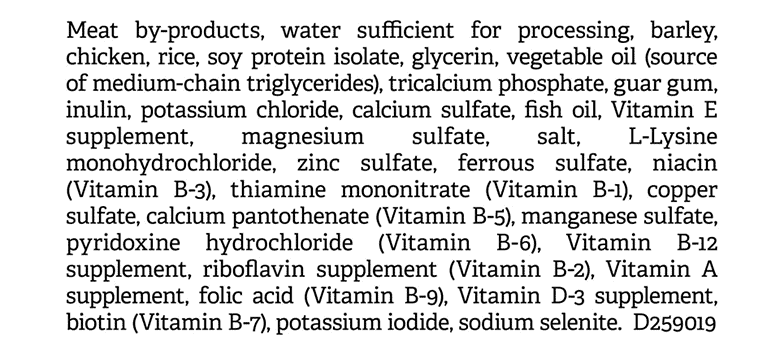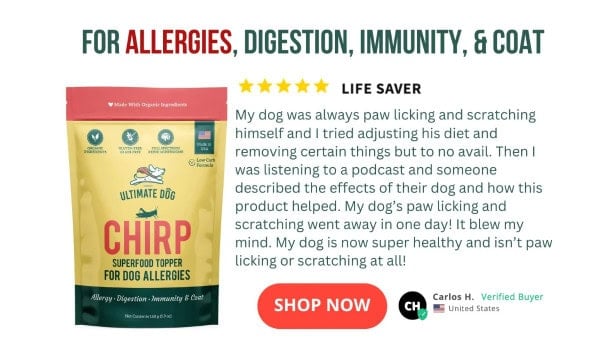When a vet prescribes a pet something, especially if they are ill or battling chronic health problems, most owners don’t hesitate to give their pet that medication. The same is usually true when a vet recommends a prescription diet.
But prescription diets are nothing like medications. Not only do you not need a prescription to purchase one through most retailers, but these diets aren’t regulated or overseen by the FDA. This means that when your vet tells you to put your pet on a special dog food, they are merely making a recommendation based on their limited knowledge of pet nutrition.
This begs the question: If prescription diets for dogs aren’t actually prescriptions, should you listen to your vet when they recommend them? In this article, we’ll take a closer look at veterinary diets to determine what about them is beneficial, what is dangerous, and how you can better support your ailing dog’s health through nutrition.
A Closer Look at Veterinary Diets
Prescription diet dog foods make a lot of claims about supporting different conditions, such as kidney disease, weight gain, and urinary problems. What they don’t do is claim to treat any specific conditions. That’s because they can’t.
If these diets claimed they cured or treated a disease, they would be subject to FDA enforcement. And that would mean the companies that create them would have to prove through scientific evaluation that these diets do what they tell veterinarians they do (and veterinarians then tell you they do).
Because they do not “treat” or “cure,” these foods are officially categorized as therapeutic diets. This means that they undergo no external regulation or testing beyond the AAFCO standards that all commercial dog food is subject to.
Finding large-scale studies on the long-term use of veterinary diet dog food is difficult. Interestingly, it is possible to find studies into the ill effects of these therapeutic diets, including this thesis that attempted to determine why so many dogs put on Hill’s Z/D allergy diet end up with diarrhea.
If prescription food for dogs doesn’t contain any medication, then what, exactly, is in these foods? A quick look at the ingredient list tells you all you need to know.
What Is In RX Dog Diets?
Here are the ingredient labels from three popular prescription diets.
Hill’s k/d with Chicken Dry Dog Food (source: Hill’s):

Royal Canin Satiety Support Weight Management Canned Dog Food (source: Royal Canin):

Purina Pro Plan Veterinary Diets EN Gastroenteric Canine Formula (source: Purina):

It doesn’t take a dog nutritionist to see very quickly that these foods do not contain the quality of ingredients you would expect from a food that costs upwards of $4.40 per pound.
Two listed here contain corn, which most people know is a cheap filler that provides very little nutritional value to dogs. Corn and other cereal ingredients also carry the potential for mycotoxin contamination. These mold toxins can make your dog very ill and even lead to death. The FDA has issued many recalls for dog food products due to deadly levels of mycotoxins introduced to the food through corn and grain ingredients.
Two also contain meat by-product meal, which has a low nutritional value at best and can be downright toxic at worst. None of these foods contain a quality protein source listed first and all contain way more carbohydrates than animal products. They’re also filled with synthetic vitamins and minerals to replace the lack of nutrition in the bulk ingredients.
But more importantly to this discussion, you’ll notice none of these foods contain ingredients that you can’t also find in bargain grocery store dog food. So what is it about them that makes them so “therapeutic” (and expensive)?
How Prescription Dog Food Works
You can find dozens of different prescription dog food products on the market. Each of them is tailored to a different disease or health concern. But the ingredients listed in all of them are suspiciously similar. They all feature low-quality meats and fats buried in a heaping of grains and finished off with a long list of synthetic vitamins and minerals.
So how do the makers decide which formula should be “prescribed” for which disease? The answer is far more subtle than you might think. And it requires taking a much closer look at the nutrition label.
A Closer Look at the Ingredients
If you look at the numerous urinary and bladder diets on the shelf at your veterinarian, you’ll eventually notice one simple theme. And that’s that all these foods contain less sodium and calcium than typical dog foods. Why? Because reducing those two ingredients has been shown to reduce kidney stones in some dogs.
Low purine diets and high vitamin E and omega fatty acid intake have also been found to be helpful in supporting the urinary system. Some prescription diets contain more of these ingredients, and some don’t.
Weight management diets, as you can probably guess, tend to have fewer calories than traditional dog food. They also contain a lot of fillers that expand in the stomach to help your dog feel fuller. The feeding guidelines on these diets are also more restrictive. Studies into using prescription weight management diets to maintain long-term weight loss have found they are effective largely due to their limited portion sizes.
Kidney diets contain less sodium, phosphorus, and protein. Since most prescription diets already contain minimal amounts of protein, the ingredient lists tend to look a lot like those on urinary diet products.
As you continue looking through the nutrition labels on these foods, you’ll notice a trend start to develop. And that’s that the “therapeutic” aspect of these diets represents only a small portion of the total ingredients. The other ingredients are chosen for their ability to meet minimal nutrition requirements while maximizing profit.
So, yes, prescription diets can be helpful, at least in the short term. But these benefits are often overshadowed by the low quality of the other ingredients used. Not only do most of the ingredients in these diets provide nothing in terms of therapy (and little in terms of nutrition) they can, in some cases, be actively harmful to your pup.
You can learn more about the ingredients used in these diets here.
The Dangers of Prescription Diets
We’ve warned time and time again about the dangers lurking in low-quality kibble and canned food. Many of those same dangerous ingredients are used in high-cost prescription diets. Feeding a healthy dog these harmful diets is not a good idea, but feeding them to an ailing dog is arguably much worse.
Many of the ingredients used in special dog diets are known to cause allergic reactions, throw the gut biome out of balance, and increase inflammation throughout the body. Some have even been found to cause cancer, impair bodily systems (including those the food is meant to support), and lead to toxicity.
Allergies
Food allergies in dogs do more than cause upset stomachs. They lead to inflammation in the gut, skin, and organs that can have secondary implications. If your dog is struggling with kidney, bladder, skin, or (of course) allergy problems, the last thing you want to do is feed them a diet packed with known common allergens.
Yet, this is exactly what you’re doing when you feed most prescription dogs diets. If you look at the ingredient lists above, you’ll find five out of the top eight most common dog food allergens well-represented: chicken, corn, soy, wheat, and eggs.
Even in special allergy dog foods, these ingredients can be common. But more worrisome in these foods is that many of the proteins used are isolates or otherwise highly processed. When proteins are changed by heat or chemical processing, they often become more likely to cause an immune response in the body.
Gut Imbalance
The number of systems we know to be affected by gut health increases every day. Everything from the immune system to the brain seems to be dependent on the biome of microbes living in the intestines of humans and canines. It would stand to reason that the first step in curing any health ailment, then, should start in the gut.
Unfortunately, most prescription pet diets come up short in this area. Very few contain probiotic additives or effective prebiotic fiber. And all contain a high amount of grains (most likely grown with glyphosate) and fillers known to increase the number of yeast and non-beneficial bacteria in the body. Worse still, many of these special dog diets utilize chemical preservatives and harsh synthetic additives that negatively affect beneficial microbes.
This interaction of food and gut may account for why many prescription diets appear to be helpful at first, only to have a resurgence of symptoms along with the appearance of new symptoms as time passes. The beneficial fraction of the food gets to work supporting your pet initially. But with time, the gut balance breaks down, causing systems throughout the body to become dysfunctional.
Inflammation
Both allergies and gut imbalances inevitably lead to inflammation in the body. But even beyond these two factors, prescription foods can be highly inflammatory.
Carboxymethylcellulose and polysorbate-80, common additives in these diets, are known to induce inflammatory bowel disease in susceptible individuals and are considered proinflammatory compounds. Carrageenan, which appears in most prescription canned foods, has been found to magnify existing chronic inflammation. And titanium dioxide, a whitening agent in many pet foods, induces oxidative stress and creates inflammation.
Dogs suffering from urinary infections, kidney disease, dermatitis, dental disease, and joint pain are already suffering from inflammation. Feeding them a diet high in inflammatory ingredients will only make things worse.
Cancer and Toxicity
Beyond inflammation, many of the additives in these foods are known to cause health problems in dogs, including cancer.
Guar gum, a common gelling agent used in wet foods, has been found to significantly decrease the protein and fat digestibility of the food, leading to metabolic issues. Propylene glycol, ethoxyquin, and sodium nitrite are all common preservatives used to preserve dog food ingredients before they are added to the food (which means they are not listed on the label). These are known to be mutagenic and carcinogenic in dogs and humans. Monosodium glutamate (MSG) is often added to prescription diets and hidden in the term “flavoring.” This common ingredient can cause many issues, from nausea to nervous system disorders.
Beyond what is supposed to be in the food, prescription diets can suffer from quality control issues just as any other commercial product can. In 2021, for instance, the FDA recalled 33 Hill’s canned food products for toxic levels of vitamin D. Twenty-six of these products were prescription diets, including a number of kidney and urinary foods. Excess vitamin D is known to cause kidney failure in healthy animals and would almost certainly be deadly to a dog already battling kidney disease.
A Better Alternative to Rx Pet Diets
So, are prescription diets for dogs worth the money? The answer seems a clear and resounding no.
These diets do contain some features that may be beneficial to dogs with specific health conditions. However, the quality of the ingredients is so poor, they may do more harm than good overall. Often, these foods contain the same questionable and dangerous ingredients as the bargain brand diets produced by the same companies and sold for a quarter of the price.
Like these low-quality, low-cost diets, veterinary dog food diets hardly contain enough nutrition to support a healthy dog. And they certainly do not do enough to support the additional health needs of a dog that is already suffering from an ailment.
In a perfect world, dog food companies would take the features of these diets that are beneficial for weight loss or kidney function and create a high-quality diet around them. It is not impossible to create a low protein, low sodium, low phosphorus diet for dogs that is made of high-quality, health-supporting ingredients. Or to create a filling yet nutrient-dense diet food to promote healthy weight. So why is no one doing it?
In the meantime, pet owners are faced with an unfortunate decision: settle for expensive, grocery-store-brand quality prescription foods or try to create their own veterinary diet at home.
Consideration for Home-Prepared Specialty Diets
If you do decide to create a homemade prescription diet for your dog, it would be wise to do so under the guidance of a certified pet nutritionist or holistic veterinarian. They can help you manage the nutrient amounts to support your pet’s condition while guiding you toward the optimal protein, fat, and carbohydrate sources for your dog’s particular needs.
Beyond ailment-specific considerations, don’t forget to include supplements that support whole-body health and reduce inflammation. Probiotics, CBD, and protein-dense additions can make a big difference in your dog’s overall health while adding additional support to the body systems that need it.
Sources
Center for Veterinary Medicine. (2019, May 20). FDA Alerts Pet Owners and Veterinarians About Potentially Toxic Levels of Vitamin D in 33 Varieties of Hill’s Canned Dog Food in Expanded Recall. U.S. Food And Drug Administration.
Craig, J. M. (2021). Additives in pet food: are they safe? Journal of Small Animal Practice, 62(8), 624–635.
German, A., Holden, S., Morris, P., & Biourge, V. (2012). Long-term follow-up after weight management in obese dogs: The role of diet in preventing regain. The Veterinary Journal, 192(1), 65–70.
Significant Hill’s Prescription Pet Food Lawsuit Will Continue. (2021, August 30). Truth About Pet Food.
Verlinden, A., Hesta, M., Millet, S., & Janssens, G. P. (2006). Food Allergy in Dogs and Cats: A Review. Critical Reviews in Food Science and Nutrition, 46(3), 259–273.
Westropp, J. L., Larsen, J. A., Johnson, E. G., Bannasch, D., Fascetti, A. J., Biourge, V., & Queau, Y. (2016). Evaluation of dogs with genetic hyperuricosuria and urate urolithiasis consuming a purine restricted diet: a pilot study. BMC Veterinary Research, 13(1).

Sara Seitz worked in the pet industry for over a decade. In addition to being a certified dog trainer, Sara gained experience working as the general manager of a dog daycare and boarding facility, as the creator and manager of a pet sitting company, as a groomer, and as a dog behavior evaluator. She also has a bachelors in animal behavior from CSU. Currently, Sara works as a freelance writer specializing in blog, article and content writing.




Leave a Comment